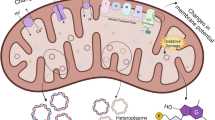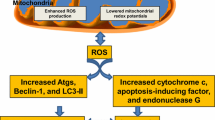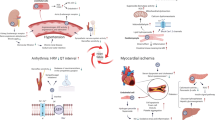Opinion statement
The pathogenesis of idiopathic cardiomyopathies is likely highly complex and remains elusive. Environmental toxins have been hypothesized to possibly cause a subset of cardiomyopathies. Epidemiological, preclinical, and small clinical studies have investigated the role of numerous elements and compounds in the pathogenesis of these myocardial disorders. In this review, we present the evidence implicating elements and environmental compounds in myocardial toxicity, including antimony, cobalt, mercury, aluminum, copper, and acrolein. We discuss their sources, toxic effects, and epidemiology, as well as identify groups at risk for toxic exposure. Through our discussion, we highlight areas where further investigation into the clinical effects of these possible toxins is warranted.
Similar content being viewed by others
References and Recommended Reading
Papers of particular interest, published recently, have been highlighted as: • Of importance •• Of major importance
Frustaci A, Sabbioni E, Fortaner S, Farina M, del Torchio R, Tafani M, et al. Selenium- and zinc-deficient cardiomyopathy in human intestinal malabsorption: preliminary results of selenium/zinc infusion. Eur J Heart Fail. 2012;14:202–10. This paper described observations from a series of patients with idiopathic dilated cardiomyopathy who had significant amount of environmental toxins in their failing myocardium.
Agency for Toxic Substances and Disease Registry (ATSDR). Toxicological profile for antimony 1992.
Agency for Toxic Substances and Disease Registry (ATSDR). Toxicological profile for cobalt 2004.
Agency for Toxic Substances and Disease Registry (ATSDR). Toxicological profile for mercury 1999.
Agency for Toxic Substances and Disease Registry (ATSDR). Toxicological profile for aluminum 2008.
Agency for Toxic Substances and Disease Registry (ATSDR). Toxicological profile for arsenic 2007.
Agency for Toxic Substances and Disease Registry (ATSDR). Toxicological profile for copper 2004.
Agency for Toxic Substances and Disease Registry (ATSDR). Toxicological profile for acrolein 2007.
Sundar S, Chakravarty J. Antimony toxicity. Int J Environ Res Public Health. 2010;7:4267–77.
Snawder JE, Tirmenstein MA, Mathias PI, Toraason M. Induction of stress proteins in rat cardiac myocytes by antimony. Toxicol Appl Pharmacol. 1999;159:91–7.
Bromberger-Barnea B, Stephens NL. Effects of antimony on myocardial performance in isolated and intact canine hearts. Am Ind Hyg Assoc J. 1965;26:404–8.
Alvarez M, Malecot CO, Gannier F, Lignon JM. Antimony-induced cardiomyopathy in guinea-pig and protection by L-carnitine. Br J Pharmacol. 2005;144:17–27.
Sundar S, Sinha PR, Agrawal NK, Srivastava R, Rainey PM, Berman JD, et al. A cluster of cases of severe cardiotoxicity among kala-azar patients treated with a high-osmolarity lot of sodium antimony gluconate. Am J Trop Med Hyg. 1998;59:139–43.
Thakur CP, Sinha GP, Pandey AK, Kumar N, Kumar P, Hassan SM, et al. Do the diminishing efficacy and increasing toxicity of sodium stibogluconate in the treatment of visceral leishmaniasis in Bihar, India, justify its continued use as a first-line drug? An observational study of 80 cases. Ann Trop Med Parasitol. 1998;92:561–9.
Winship KA. Toxicity of antimony and its compounds. Adverse Drug React Acute Poisoning Rev. 1987;6:67–90.
Gilbert CJ, Cheung A, Butany J, Zywiel MG, Syed K, McDonald M, et al. Hip pain and heart failure: the missing link. Can J Cardiol. 2013;29:639.e1–2.
Machado C, Appelbe A, Wood R. Arthroprosthetic cobaltism and cardiomyopathy. Heart Lung Circ. 2012;21:759–60.
van Lingen CP, Ettema HB, Timmer JR, de Jong G, Verheyen CC. Clinical manifestations in ten patients with asymptomatic metal-on-metal hip arthroplasty with very high cobalt levels. Hip Int. 2013;23:441–4. Interesting case series on cobalt cardiomyopathy associated with hip prosthesis.
Oldenburg M, Wegner R, Baur X. Severe cobalt intoxication due to prosthesis wear in repeated total hip arthroplasty. J Arthroplasty. 2009;24:825.e15–20.
Centeno JA, Pestaner JP, Mullick FG, Virmani R. An analytical comparison of cobalt cardiomyopathy and idiopathic dilated cardiomyopathy. Biol Trace Elem Res. 1996;55:21–30.
Kempf I, Semlitsch M. Massive wear of a steel ball head by ceramic fragments in the polyethylene acetabular cup after revision of a total hip prosthesis with fractured ceramic ball. Arch Orthop Trauma Surg. 1990;109:284–7.
Morin Y, Tetu A, Mercier G. Cobalt cardiomyopathy: clinical aspects. Br Heart J. 1971;33(Suppl):175–8.
Morin Y, Tetu A, Mercier G. Quebec beer-drinkers’ cardiomyopathy: clinical and hemodynamic aspects. Ann N Y Acad Sci. 1969;156:566–76.
Clyne N, Hofman-Bang C, Haga Y, Hatori N, Marklund SL, Pehrsson SK, et al. Chronic cobalt exposure affects antioxidants and ATP production in rat myocardium. Scand J Clin Lab Invest. 2001;61:609–14.
Topuzoglu G, Erbay AR, Karul AB, Yensel N. Concentrations of copper, zinc, and magnesium in sera from patients with idiopathic dilated cardiomyopathy. Biol Trace Elem Res. 2003;95:11–7.
Tchounwou PB, Ayensu WK, Ninashvili N, Sutton D. Environmental exposure to mercury and its toxicopathologic implications for public health. Environ Toxicol. 2003;18:149–75.
Bryan CE, Davis WC, McFee WE, Neumann CA, Schulte J, Bossart GD, et al. Influence of mercury and selenium chemistries on the progression of cardiomyopathy in pygmy sperm whales, Kogia breviceps. Chemosphere. 2012;89:556–62.
Cooper LT, Rader V, Ralston NV. The roles of selenium and mercury in the pathogenesis of viral cardiomyopathy. Congest Heart Fail. 2007;13:193–9.
Koller LD. Methylmercury: effect on oncogenic and nononcogenic viruses in mice. Am J Vet Res. 1975;36:1501–4.
South PK, Morris VC, Levander OA, Smith AD. Mortality in mice infected with an amyocarditic coxsackievirus and given a subacute dose of mercuric chloride. J Toxicol Environ Health A. 2001;63:511–23.
Ilback NG, Lindh U, Wesslen L, Fohlman J, Friman G. Trace element distribution in heart tissue sections studied by nuclear microscopy is changed in Coxsackie virus B3 myocarditis in methyl mercury-exposed mice. Biol Trace Elem Res. 2000;78:131–47. Evidence in susceptibility of viral myocarditis with mercury exposure.
Christensen MM, Ellermann-Eriksen S, Rungby J, Mogensen SC. Influence of mercuric chloride on resistance to generalized infection with herpes simplex virus type 2 in mice. Toxicology. 1996;114:57–66.
Gainer JH. Effects of heavy metals and of deficiency of zinc on mortality rates in mice infected with encephalomyocarditis virus. Am J Vet Res. 1977;38:869–72.
Ilback NG, Wesslen L, Fohlman J, Friman G. Effects of methyl mercury on cytokines, inflammation and virus clearance in a common infection (coxsackie B3 myocarditis). Toxicol Lett. 1996;89:19–28.
Nyland JF, Fairweather D, Shirley DL, Davis SE, Rose NR, Silbergeld EK. Low-dose inorganic mercury increases severity and frequency of chronic coxsackievirus-induced autoimmune myocarditis in mice. Toxicol Sci. 2012;125:134–43.
Rayman MP. The importance of selenium to human health. Lancet. 2000;356:233–41.
Reusche E, Koch V, Friedrich HJ, Nunninghoff D, Stein P, Rob PM. Correlation of drug-related aluminum intake and dialysis treatment with deposition of argyrophilic aluminum-containing inclusions in CNS and in organ systems of patients with dialysis-associated encephalopathy. Clin Neuropathol. 1996;15:342–7.
Hall JC, Harruff R. Fatal cardiac arrhythmia in a patient with interstitial myocarditis related to chronic arsenic poisoning. South Med J. 1989;82:1557–60.
Brook RD, Rajagopalan S, Pope 3rd CA, Brook JR, Bhatnagar A, Diez-Roux AV, et al. Particulate matter air pollution and cardiovascular disease: an update to the scientific statement from the American Heart Association. Circulation. 2010;121:2331–78. Scientific statement regarding the contributions of air pollution in cardiovascular disease.
Pope 3rd CA, Burnett RT, Thurston GD, Thun MJ, Calle EE, Krewski D, et al. Cardiovascular mortality and long-term exposure to particulate air pollution: epidemiological evidence of general pathophysiological pathways of disease. Circulation. 2004;109:71–7.
Brook RD, Rajagopalan S. Particulate matter air pollution and atherosclerosis. Curr Atheroscler Rep. 2010;12:291–300.
DeWoskin R. Toxicological review of acrolein (Cas No. 107-02-08) in support of summary information on the Integrated Risk Information System (Iris). 2003.
Bhatnagar A. Environmental cardiology: studying mechanistic links between pollution and heart disease. Circ Res. 2006;99:692–705.
Haussmann HJ. Use of hazard indices for a theoretical evaluation of cigarette smoke composition. Chem Res Toxicol. 2012;25:794–810.
Anderson MM, Hazen SL, Hsu FF, Heinecke JW. Human neutrophils employ the myeloperoxidase-hydrogen peroxide-chloride system to convert hydroxy-amino acids into glycolaldehyde, 2-hydroxypropanal, and acrolein. A mechanism for the generation of highly reactive alpha-hydroxy and alpha,beta-unsaturated aldehydes by phagocytes at sites of inflammation. J Clin Invest. 1997;99:424–32.
Ghilarducci DP, Tjeerdema RS. Fate and effects of acrolein. Rev Environ Contam Toxicol. 1995;144:95–146.
Uchida K. Current status of acrolein as a lipid peroxidation product. Trends Cardiovasc Med. 1999;9:109–13.
Watanabe K, Nakazato Y, Saiki R, Igarashi K, Kitada M, Ishii I. Acrolein-conjugated low-density lipoprotein induces macrophage foam cell formation. Atherosclerosis. 2013;227:51–7.
Sun Y, Ito S, Nishio N, Tanaka Y, Chen N, Isobe K. Acrolein induced both pulmonary inflammation and the death of lung epithelial cells. Toxicol Lett. 2014;229:384–92.
Hazari MS, Griggs J, Winsett DW, Haykal-Coates N, Ledbetter A, Costa DL, et al. A single exposure to acrolein desensitizes baroreflex responsiveness and increases cardiac arrhythmias in normotensive and hypertensive rats. Cardiovasc Toxicol. 2014;14:52–63.
Ismahil MA, Hamid T, Haberzettl P, Gu Y, Chandrasekar B, Srivastava S, et al. Chronic oral exposure to the aldehyde pollutant acrolein induces dilated cardiomyopathy. Am J Physiol Heart Circ Physiol. 2011;301:H2050–60.
Shah AS, Langrish JP, Nair H, McAllister DA, Hunter AL, Donaldson K, et al. Global association of air pollution and heart failure: a systematic review and meta-analysis. Lancet. 2013;382:1039–48.
DeJarnett N, Conklin DJ, Riggs DW, Myers JA, O’Toole TE, Hamzeh I, et al. Acrolein exposure is associated with increased cardiovascular disease risk. J Am Heart Assoc. 2014;3:10.1161/JAHA.114.000934.
Acknowledgments
This work is supported in part by National Institutes of Health grant R01HL103931.
Compliance With Ethics Guidelines
Conflict of Interest
Dr. Antonio L. Perez declares no potential conflicts of interest.
Dr. Wilson Tang is a section editor for Current Treatment Options in Cardiovascular Medicine.
Human and Animal Rights and Informed Consent
This article does not contain any studies with human or animal subjects performed by any of the authors.
Author information
Authors and Affiliations
Corresponding author
Additional information
This article is part of the Topical Collection on Heart Failure
Rights and permissions
About this article
Cite this article
Perez, A.L., Tang, W.H.W. Contribution of Environmental Toxins in the Pathogenesis of Idiopathic Cardiomyopathies. Curr Treat Options Cardio Med 17, 19 (2015). https://doi.org/10.1007/s11936-015-0381-2
Published:
DOI: https://doi.org/10.1007/s11936-015-0381-2




